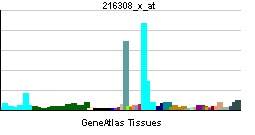GRHPR
| Glyoxylate reductase/hydroxypyruvate reductase | |||||||||||||
|---|---|---|---|---|---|---|---|---|---|---|---|---|---|
 PDB rendering based on 2gcg. | |||||||||||||
| |||||||||||||
| Identifiers | |||||||||||||
| Symbols | GRHPR ; PH2; GLXR | ||||||||||||
| External IDs | Template:OMIM5 Template:MGI HomoloGene: 49088 | ||||||||||||
| |||||||||||||
| RNA expression pattern | |||||||||||||
 | |||||||||||||
 | |||||||||||||
 | |||||||||||||
| More reference expression data | |||||||||||||
| Orthologs | |||||||||||||
| Template:GNF Ortholog box | |||||||||||||
| Species | Human | Mouse | |||||||||||
| Entrez | n/a | n/a | |||||||||||
| Ensembl | n/a | n/a | |||||||||||
| UniProt | n/a | n/a | |||||||||||
| RefSeq (mRNA) | n/a | n/a | |||||||||||
| RefSeq (protein) | n/a | n/a | |||||||||||
| Location (UCSC) | n/a | n/a | |||||||||||
| PubMed search | n/a | n/a | |||||||||||
Glyoxylate reductase/hydroxypyruvate reductase, also known as GRHPR, is a human gene.[1]
This gene encodes an enzyme with hydroxypyruvate reductase, glyoxylate reductase, and D-glycerate dehydrogenase enzymatic activities. The enzyme has widespread tissue expression and has a role in metabolism. Type II hyperoxaluria is caused by mutations in this gene.[1]
References
Further reading
- Takayama T, Nagata M, Ozono S; et al. (2007). "A novel mutation in the GRHPR gene in a Japanese patient with primary hyperoxaluria type 2". Nephrol. Dial. Transplant. 22 (8): 2371–4. doi:10.1093/ndt/gfm271. PMID 17510093.
- Booth MP, Conners R, Rumsby G, Brady RL (2006). "Structural basis of substrate specificity in human glyoxylate reductase/hydroxypyruvate reductase". J. Mol. Biol. 360 (1): 178–89. doi:10.1016/j.jmb.2006.05.018. PMID 16756993.
- Mehrle A, Rosenfelder H, Schupp I; et al. (2006). "The LIFEdb database in 2006". Nucleic Acids Res. 34 (Database issue): D415–8. doi:10.1093/nar/gkj139. PMID 16381901.
- Wiemann S, Arlt D, Huber W; et al. (2004). "From ORFeome to biology: a functional genomics pipeline". Genome Res. 14 (10B): 2136–44. doi:10.1101/gr.2576704. PMID 15489336.
- Gerhard DS, Wagner L, Feingold EA; et al. (2004). "The status, quality, and expansion of the NIH full-length cDNA project: the Mammalian Gene Collection (MGC)". Genome Res. 14 (10B): 2121–7. doi:10.1101/gr.2596504. PMID 15489334.
- Lehner B, Sanderson CM (2004). "A protein interaction framework for human mRNA degradation". Genome Res. 14 (7): 1315–23. doi:10.1101/gr.2122004. PMID 15231747.
- Ota T, Suzuki Y, Nishikawa T; et al. (2004). "Complete sequencing and characterization of 21,243 full-length human cDNAs". Nat. Genet. 36 (1): 40–5. doi:10.1038/ng1285. PMID 14702039.
- Strausberg RL, Feingold EA, Grouse LH; et al. (2003). "Generation and initial analysis of more than 15,000 full-length human and mouse cDNA sequences". Proc. Natl. Acad. Sci. U.S.A. 99 (26): 16899–903. doi:10.1073/pnas.242603899. PMID 12477932.
- Simpson JC, Wellenreuther R, Poustka A; et al. (2001). "Systematic subcellular localization of novel proteins identified by large-scale cDNA sequencing". EMBO Rep. 1 (3): 287–92. doi:10.1093/embo-reports/kvd058. PMID 11256614.
- Hartley JL, Temple GF, Brasch MA (2001). "DNA cloning using in vitro site-specific recombination". Genome Res. 10 (11): 1788–95. PMID 11076863.
- Webster KE, Ferree PM, Holmes RP, Cramer SD (2000). "Identification of missense, nonsense, and deletion mutations in the GRHPR gene in patients with primary hyperoxaluria type II (PH2)". Hum. Genet. 107 (2): 176–85. PMID 11030416.
- Huang T, Yang W, Pereira AC; et al. (2000). "Cloning and characterization of a putative human d-2-hydroxyacid dehydrogenase in chromosome 9q". Biochem. Biophys. Res. Commun. 268 (2): 298–301. doi:10.1006/bbrc.2000.2122. PMID 10679197.
- Rumsby G, Cregeen DP (1999). "Identification and expression of a cDNA for human hydroxypyruvate/glyoxylate reductase". Biochim. Biophys. Acta. 1446 (3): 383–8. PMID 10524214.
- Cramer SD, Ferree PM, Lin K; et al. (1999). "The gene encoding hydroxypyruvate reductase (GRHPR) is mutated in patients with primary hyperoxaluria type II". Hum. Mol. Genet. 8 (11): 2063–9. PMID 10484776.
| This protein-related article is a stub. You can help Wikipedia by expanding it. |